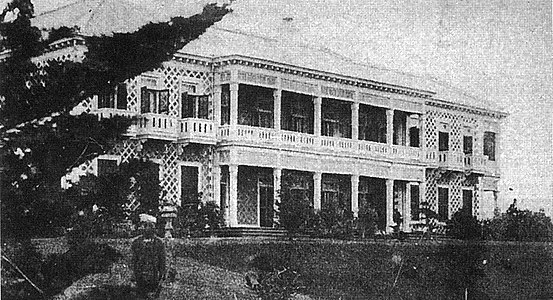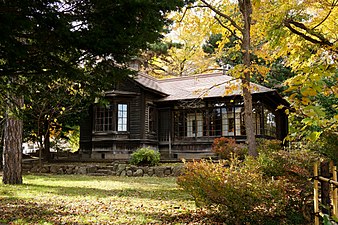Japanese-Western Eclectic Architecture
Japanese-Western Eclectic Architecture (Japanese: 和洋折衷建築, Hepburn: Wayō Se'chū Kenchiku) is an architectural style that emerged from the Eclecticism in architecture movement of the late 19th and early 20th century, which intentionally incorporated Japanese architectural and Western architectural components into one building design. The style is both a precursor to and a style of Modern Japanese Architecture (近代和風建築, Kindai Wafū Kenchiku).
The style emerged in Yokohama in the 1853–1867 Bakumatsu period, and spread throughout Japan after the 1868 Meiji Restoration, and then to Asian and Western countries during the expansion of the Empire of Japan.[1]
This architectural style is characterised by both components of enlightenment Western-style architecture and components of historically emblematic traditional Japanese architecture.[1]
Buildings that are early exemplary representations of this style are: The First National Bank of Japan (第一国立銀行, Daiichi Kokuritsu Ginkō) built by Mistui Group (三井組, Mistui Gumi) in 1872, the Kaichi School Museum building built in 1876, and Seika Restaurant (清華亭, Seika Tei) built in 1881.
History
[edit]The earliest examples of Japanese-Western Eclectic Architecture were built by the French government as part of the Japonism artistic movement's influence on French architecture.[2] The term Japanese-Western Eclectic Architecture had been used by Waseda University sociologist Wajiro Kon, in his 1925 survey of housing recently built along the Chūō Main Line in Tokyo.[3] Wajiro reviewed 588 houses built in 1921 near Asagaya Station and categorised them as Japanese Style, Culture Style, and Japanese Western Style respectively.[3] In Kon's original thesis, the single criterion that needed to be met for classifying a house as Japanese Western Eclectic Architecture was the inclusion of a Western style Visitor's Room (応接室, Ousetsu Shitsu).[4]
Examples of Japanese-Western Eclectic Architectural Styles
[edit]The Japanese-Western Eclectic Architecture emerged in the final years of the Edo period in Yokohama, and then spread to other parts of Japan. The development of the style started with early architectural examples from Yokohama.
Bakumatsu Period Yokohama
[edit]These examples were built within the Foreign settlement (外国人居留地, Gaikokujin Kyoryū Chi) jurisdiction, where the military Bakumatsu government had allowed concessions to foreign governments.
-
The French Naval Hospital built in 1865 is a distinct derivative of Japanese Western Architectural Style called Giyōfū architecture.
-
The French Military Station built in 1864.
-
The British Provisional Legation built in 1867
Post Meiji Restoration
[edit]-
The First National Bank of Japan (1872)
-
Former Kaichi School in the Kaichi School Museum Building in one of the Japanese-Western Eclectic Architectural styles called Giyōfu architecture
-
Fujiya Hotel established in 1878, Hakone
-
Pavilion of the Fujiya Hotel, Hakone
-
Former Saiseikan hospital built in 1878, Yamagata Prefecture
-
Seika Restaurant (1881)
-
Shayokan built in 1907, was the birthplace of author Dazai Osamu.
-
Western style staircase of Shayokan
-
Makiki Christian Church building, Hawaii, completed in 1934.
-
The Hyokeikan wing of the Tokyo National Museum, first opened in 1909.
References
[edit]- ^ Jump up to: a b Hatsuta, Kō (2001). "和洋折衷建築" [Japanese Western Eclectic Architecture]. 日本歴史大辞典3 [The Great Dictionary of Japanese History 3] (in Japanese). Japan: Shogakkan. ISBN 9784095230030.
- ^ Ono, Ayako (2003). Japonisme in Britain: Whistler, Menpes, Henry, Hornel and nineteenth-century Japan. New York: Routledge Curzon. p. 1.
- ^ Jump up to: a b サンド, ジョルダン (2009). "社会と制度 「文化住宅」というメディア文化の産物" [Society and Systems, Bunka Jyūtaku as a Product of Media Culture]. In 鈴木, 博之 (ed.). 建築史攷 [Studies in Architectural History] (in Japanese). 東京: 中央公論美術出版. pp. 489–512. ISBN 9784805506226. OCLC 462794641.
- ^ 平井, 聖 (2003). "応接室" [Visitor's Room] (Online). 日本大百科全書 (in Japanese). Japan: 小学館. Retrieved 2017-08-06.















